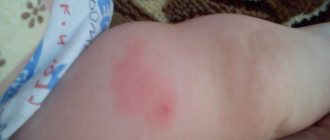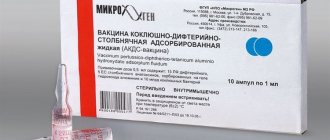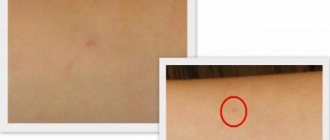Vaccination is a necessary measure. And this is the only way to protect your baby from various infections. And since any immunization is, in fact, an artificial (albeit small) infection, the child’s body is forced to fight it.
DTP vaccination is not the most pleasant procedure; moreover, it is a complex drug that protects against several diseases at once. Therefore, the immune system must “try” to cope with the infection. After DPT vaccination, redness is perhaps the most common reaction of the body to injected pathogens. But should we be afraid of this?
Red spot on the thigh after DPT vaccination: normal or complication?
DTP is the vaccination to which a small patient always reacts to varying degrees of intensity. The area where the vaccine is injected often turns red. A slight swelling may form. This is very frightening for parents, but only for those who do not distinguish a normal local reaction from a truly serious complication to the vaccine.
DPT vaccine
Redness at the injection site is not dangerous if it does not exceed 6-7 cm. Normally, it should be about 2 cm in diameter. Why does the skin turn red? This is the body’s reaction to artificial infection (and this is vaccination) with pathogenic microorganisms.
There are three of them in DTP: whooping cough, diphtheria and tetanus. This is a serious test for the baby's immune system, since it needs to produce antibodies for each type of pathogenic bacteria. Redness is evidence that the body has begun an “attack” on infectious elements. How to distinguish a normal reaction from a complication?
Observe the injection site. The redness should fade and disappear quite quickly - within 2-3 days. This is typical for inactivated vaccines (including DPT). And this is how they differ from “live” drugs, in which similar reactions occur after a week.
Redness and hardness at the injection site (according to statistics) are diagnosed in every 4th baby. This shouldn't scare parents. It is also important to know that such a reaction will be more pronounced with the 2nd and 3rd vaccinations.
This is understandable, because when DPT was introduced for the first time, the immune system was just beginning to “get acquainted” with pathogens and did not have time to develop protection in the form of specific cells - lymphocytes.
But with subsequent vaccinations, their number has already become sufficient to “repel” strangers - antigens. And outwardly this manifests itself in redness of the puncture site. But such a reaction is expected, because it indicates a “correct” immune response.
If the redness goes away in the first days after the injection, then we can assume that the procedure went “excellent”.
Timing of vaccination
The first DTP vaccine is given to babies at the age of three months. According to the plan, it is combined with the introduction of inactivated polio vaccine. In total, during the first half of the year, the child is given such immunization three times (3, 4.5, 6 months). The interval between injections must be at least 1-1.5 months.
An important part of the formation of an immune response is timely revaccination. According to the plan, it begins 12 months after the third DTP vaccination with polio and, if followed, has the following form:
- 18 months – first revaccination (adsorbed pertussis-diphtheria-tetanus suspension);
- 20 months – administration of a polio suspension;
- 6 years – second revaccination against tetanus and diphtheria with ADS-M solution (pertussis component excluded);
- 14 years – 2nd revaccination, which allows you to form protection against polio infection.
Why does the injection site on a child’s leg become red, swollen and hard?
DTP is a complex vaccination. Almost all kids respond to it. In addition to redness of the injection site, hardening or swelling may occur.
This is often diagnosed after the introduction of Pentaxim. Not only the thigh where the drug is injected may become swollen and red, but also the entire leg.
There is no need to be afraid of this situation, since each child’s immunity is individual and copes with the infection to the best of its ability.
For this reason, one baby may experience severe redness of the skin, while another may not have it at all. But in any case, such symptoms are considered normal, since they confirm that the body has launched an “attack” on pathogenic organisms, forming a specific defense against them - immunity. And this is the goal of any vaccination.
Even if the injection site is red and swollen, but the baby steps on the leg - this is a normal reaction. You should only worry if the redness does not subside, but, on the contrary, increases in size, exceeding 7-8 cm in diameter, and the injection site swells and hurts.
If the baby has difficulty walking and limps, this is already a complication. What's going on? It's all about the slow resorption of the injected vaccine. Lameness will go away as soon as the infiltrate dissolves in the tissues. This may take 7-8 days.
If the swelling and redness are severe and the leg is hot to the touch, immediately show the baby to the surgeon. Don't treat yourself. Coordinate therapy with your local pediatrician.
Imported analogues
Despite all the positive qualities of domestic drugs, their foreign analogues are safer and hypoallergenic. Among the imported vaccine preparations, the most popular are:
- the French drug "Pentaxim", which allows you to significantly reduce the number of vaccinations, as it contains vaccines against major infections (measles, tetanus, polio, Haemophilus influenzae, diphtheria);
- the drug "Infanrix" of Belgian origin is a high-quality analogue of DTP that does not contain merthiolate, which is very easily tolerated by the body;
- the combination drug from France “Tetraxim” is an excellent alternative to the adsorbed vaccine and OPV.
If thickening and redness appear after DTP vaccination, what should you do?
The main thing is not to panic. Parents should understand that each child reacts to the vaccine differently. Watch the baby. He must be cheerful and active, have a good appetite.
You can walk, but you should dress carefully, trying not to touch or squeeze the reddened injection site. Monitor reactions to the vaccine. Normally, redness at the puncture site can reach 8-10 cm in diameter. Take your time to start treatment; the redness should disappear on its own.
You just need to wait until the infiltrate resolves. If the baby complains about his foot and does not step on it, you can give him Paracetamol or Ibuprofen. If the child is bothered by pain at the injection site, a compress with Novocaine should be made. To do this, gauze is moistened in the solution and the lotion is carefully secured to the baby’s leg.
Among the folk methods, you can try a cabbage leaf compress. To do this, first knead it or tap it with a hammer so that the juice comes out. Then the sheet is wrapped around the sore spot and fixed until it dries completely. Cabbage juice effectively relieves inflammation and redness.
Sometimes doctors advise using a vodka compress. It is done simply: gauze (or cotton cloth) is moistened in alcohol and applied to the reddened area. After 2 hours, the application is changed to a fresh one. And so on all day.
Keep an eye on your baby at all times. He should not be allowed to scratch the injection site. Dress the child so that he cannot reach the sore area. Tight pants or tights should be avoided.
Clothing should be loose and not put pressure on the inflamed area. You should not heat the injection site, even if the redness seems too great to you. This can cause an abscess.
Remember that both redness and thickening during the post-injection period are normal if the child feels well.
How to treat the injection site if it is inflamed and burning?
If the redness is too severe, you should apply Troxevasin ointment . The active components in the product cope well with inflammation. It is recommended to use the ointment twice a day.
Troxevasin ointment
It is carefully applied to the redness in a small layer (until completely absorbed). Contraindications to the ointment include: allergies to the components of the product and dermatitis.
What to do if the redness grows and thickens?
It is best to consult a doctor. Only he will professionally assess the severity of the situation and give the necessary recommendations. Doctors warn parents that they should not handle post-vaccination reactions on their own.
Any ointments or compresses (without consultation with the pediatrician) can aggravate the situation. If the redness continues to increase, and the injection site becomes more and more dense and painful, it means that the vaccination was carried out incorrectly.
Most likely, the wound got infected. This is dangerous due to the development of an abscess (accumulation of pus in the infiltrate). But the reason may also be individual intolerance to the composition of the vaccine. To prevent this from happening, the baby must be thoroughly examined before immunization and be absolutely healthy at the time of vaccination.
What are the signs of an abscess? They are as follows:
- tissue softening is felt in the compaction;
- in the center of the abscess the skin becomes thinner. Therefore, an abscess can open on its own if it is located superficially;
- the skin in the affected area is bright red and hot;
- body temperature from 39 and above;
- throbbing pain at the site of swelling.
Such compaction will not go away on its own. He needs to be operated on, which means contacting a surgeon. If the doctor only suspects the presence of an abscess, the baby is given an ultrasound. The danger of a post-vaccination abscess is that it can break out on its own at any time.
Then the pus will enter the closed cavities and spread the infection throughout the body. After surgery, the baby is prescribed antibacterial drugs.
To prevent such situations from happening, parents should prepare for vaccination. You should find out in advance the quality of the drug offered by the clinic.
And if in doubt, purchase the vaccine yourself. It is equally important to prepare your baby for vaccination.
The day before (two days before the procedure) and after it, protect your child from negative psycho-emotional moments. It is very important that the child does not get sick on the day of vaccination, this will weaken his immunity, and vaccination may be difficult.
Be sure to make sure that the baby has no contraindications to the administered drug. If the preparation is carried out correctly and the injection is done correctly, there is nothing to fear.
Contraindications
Vaccination is postponed until recovery from acute respiratory infections or fever. Absolute exemptions for any vaccination, including DTP and polio, are as follows:
- intolerance to vaccines or their components;
- allergic reaction to the first injection;
- allergy to antibiotics if IPV is used against polio.
Vaccination is temporarily postponed for children with exacerbation of diathesis.
A joint DTP and polio vaccination protects the baby from four dangerous infections at once from a very early age. Immunization against these diseases is included in the national vaccination calendar and it is no coincidence that it is carried out at the same time, since with proper preparation of the child, possible side effects are minimized. To further facilitate the tolerability of the procedure, DTP and OPV can be replaced with a combined imported vaccine.
source











